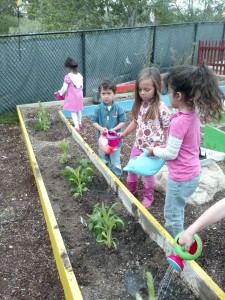Learning about earth science, health and nutrition through gardening growing our own squash, beans and corn with Teacher Ron
Spring has sprung at La Costa Valley Preschool and Kindergarten and this includes learning about where our food comes from and how it goes from seed to table.
 Via: Wikipedia on Three Sisters (agriculture)
Via: Wikipedia on Three Sisters (agriculture)
Technique known as companion planting, the three crops are planted close together. Flat-topped mounds of soil are built for each cluster of crops.[1] Each mound is about 30 cm (12 in) high and 50 cm (20 in) wide, and several maize seeds are planted close together in the center of each mound. In parts of the Atlantic Northeast, rotten fish or eels are buried in the mound with the maize seeds, to act as additional fertilizer where the soil is poor.[2][3] When the maize is 15 cm (6 inches) tall, beans and squash are planted around the maize, alternating between the two kinds of seeds.
The three crops benefit from each other. The maize provides a structure for the beans to climb, eliminating the need for poles. The beans provide the nitrogen to the soil that the other plants utilize, and the squash spreads along the ground, blocking the sunlight, helping prevent establishment of weeds. The squash leaves also act as a “living mulch”, creating a microclimate to retain moisture in the soil, and the prickly hairs of the vine deter pests. Maize lacks the amino acids lysine and tryptophan, which the human body needs to make proteins and niacin, but beans contain both and therefore maize and beans together provide a balanced diet.
Native Americans throughout North America are known for growing variations of Three Sisters gardens. The milpas of Mesoamerica are farms or gardens that employ companion planting on a larger scale.[4] The Anasazi are known for adopting this garden design in a drier environment. The Tewa and other Southwest tribes often included a “fourth sister” known as “Rocky Mountain bee plant” (Cleome serrulata), which attracts bees to help pollinate the beans and squash.[5]
Why our students learn about gardening and food.
- Gardening offers hands-on, experience learning that helps to build skills in, natural and social sciences, math, language arts ( garden journal), visual arts ( design ), and nutrition and health.
- Gardening helps the kids to connect with nature and learn about environmental responsibility.
- Encourages healthy eating and nutrition awareness, as during planting and nurturing the children learn about the vegetables that they are growing including vitamins, minerals and more. Kids will eat what they grow and the more we can help them to choose healthy foods at a young age the possibility they will continue to choose healthy options as they move forward through their lives.
